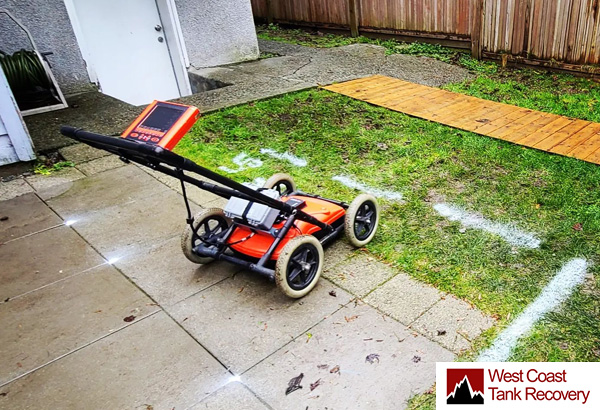 Fully Licensed and Insured
Fully Licensed and Insured Request an Oil Tank Scan
Request an Oil Tank Scan Request a Free Estimate
Request a Free Estimate

So, you suspect that there may be an undergoing oil tank on your property but do not relish the idea of digging up large swaths of land just to be sure. Well, the good news is that you don’t have to. Have you ever wondered how archaeologists and engineers uncover hidden structures beneath the ground without digging? The answer lies in a technology known as Ground Penetrating Radar (GPR).
Ground Penetrating Radar (GPR) is a non-destructive geophysical method that uses electromagnetic waves to map the subsurface and identify underground features. It allows us to visualize and analyze the hidden layers of soil, rocks, concrete, and other materials without any excavation and has become an essential tool in locating hidden underground oil tanks.
Ground Penetrating Radar (GPR) is a non-destructive method of mapping the subsurface to identify hidden underground objects. It can provide an accurate location of buried oil tanks based on the reflections of radar waves off the tank and surrounding soil.
By using GPR tank locating, professionals can visualize and assess the presence, position, and condition of underground oil tanks without resorting to expensive and disruptive excavation methods.
As the name suggests, GPR operates based on radar principles, emitting high-frequency electromagnetic pulses into the ground through a transmitting antenna. These pulses travel through the subsurface, encountering various materials and obstacles along the way before bouncing back up to a receiving antenna, where a computer displays the visual results of the distortions encountered. Trained operators can then analyze the size and distribution of the reflections captured by the GPR to help uncover the existence and location of an underground oil tank.
While GPR oil tank detection is a highly effective means of locating underground oil tanks, several factors can influence its performance.
Radar wave frequency determines the depth of penetration and the resolution. A higher frequency provides better resolution but has limited depth penetration, while a lower frequency can collect data from a greater depth but delivers lower resolution results. Soil composition, moisture content, and the presence of other underground objects can also impact the GPR’s ability to detect and differentiate oil tanks, and this is where the skill of the operation becomes extremely important.
The main advantage of utilizing GPR for underground oil tank locating is that it allows for non-destructive assessment, eliminating the need for costly excavation unless verification or oil tank removal is required. Compared to other means of oil tank locating, such as soil sampling and testing, GPR surveys are efficient, affordable, and provide rapid results while minimizing disruption to the surrounding area.
What’s more, GPR technology can accurately not only identify the presence of tanks but also estimate their size and map their location, which helps in planning for efficient oil tank removal.
Given its ability to accurately locate the existence of an underground oil tank without disruption to the surrounding property, it’s no surprise that Ground Penetrating Radar (GPR) has become one of the most commonly used methods for oil tank locating. GPR enables professionals to accurately identify, locate, and map hidden tanks, streamlining oil tank management processes and ensuring the health and safety of your home.